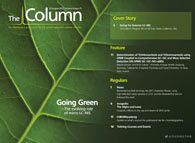Candid UTLC Camera
A team of researchers from Canada has investigated the use of high-definition video cameras to detect nanolitre analyte volumes.

A team of researchers from Canada has investigated the use of high-definition video cameras to detect nanolitre analyte volumes.1
Using ultrathin-layer chromatography (UTLC) and a Canon EOS Rebel T2i digital single lens reflex capable of capturing 1920 × 1080 pixels at 30 frames a second, the team was able to record UTLC separations in full colour with 32 μm spatial resolution and 33 ms temporal resolution.
Michael Taschuk, a research associate working on the project, commented: “We had been investigating the performance of our nanostructured UTLC plates for some time, and had grown frustrated with losing our best results to post separation processing — removing the plate from the chamber, drying it and scanning it all carried a risk of distorting the chromatogram. We could see very, very nice results by eye, but weren’t able to capture them. With that in mind, we wanted an in-situ measurement system that would allow us to measure the true performance of our plates.”
To evaluate their detection method, a mixture of five dyes of different colours were analysed. To produce the chromatograms required the selection of an appropriate hue range for each of the five dye components as they migrated along the plate. Careful monitoring was able to achieve this tracking.
The team concluded that their experiment captured a great deal of information from a UTLC separation, and could potentially provide insight into UTLC physics and improved analytical performance. Taschuk added, “This new instrument has become part of our standard process — all of our separations take place under the TR-UTLC system. We are now designing and testing new plates that take advantage of our new measurement capabilities, and have some promising results that we hope to report soon. We’re very excited, and are hoping to push the boundaries of what is possible for UTLC.”
1. M.J. Brett et al., Journal of Chromatography A1249, 226–232 (2012).
This story originally appeared in The Column. Click here to view that issue.
Regulatory Deadlines and Supply Chain Challenges Take Center Stage in Nitrosamine Discussion
April 10th 2025During an LCGC International peer exchange, Aloka Srinivasan, Mayank Bhanti, and Amber Burch discussed the regulatory deadlines and supply chain challenges that come with nitrosamine analysis.











